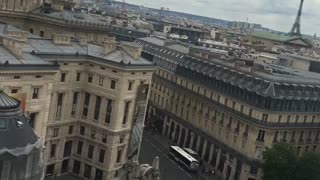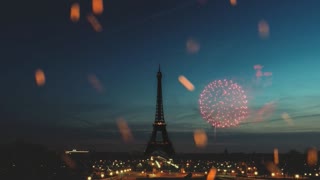Champs de Alysee streest Paris and triumphal arch
The Avenue des Champs-Élysées (UK: /ˌʃɒ̃z eɪˈliːzeɪ, - ɛˈ-/, US: /ʃɒ̃z ˌeɪliːˈzeɪ/, French: [av(ə)ny de ʃɑ̃z‿elize] (About this soundlisten)) is an avenue in the 8th arrondissement of Paris, France, 1.9 kilometres (1.2 mi) long and 70 metres (230 ft) wide, running between the Place de la Concorde and the Place Charles de Gaulle, where the Arc de Triomphe is located. It is known for its theatres, cafés, and luxury shops, for the annual Bastille Day military parade, and as the finish of the Tour de France cycling race.
The name is French for the Elysian Fields, the place for dead heroes in Greek mythology. Champs-Élysées is widely regarded to be one of the most recognisable avenues in the world.
The avenue runs for 1.91 km (1.19 mi) through the 8th arrondissement in northwestern Paris, from the Place de la Concorde in the east, with the Obelisk of Luxor,[1] to the Place Charles de Gaulle (formerly the Place de l'Étoile) in the west, location of the Arc de Triomphe. The Champs-Élysées forms part of the Axe historique.
The lower part of the Champs-Élysées, from the Place de la Concorde to the Rond-Point, runs through the Jardin des Champs-Élysées, a park which contains the Grand Palais, the Petit Palais, the Théâtre Marigny, and several restaurants, gardens and monuments. The Élysée Palace—official residence of the President of the French Republic—borders the park, but is not on the Avenue itself. The Champs-Élysées ends at the Arc de Triomphe, built to honour the victories of Napoleon Bonaparte.
Until the reign of Louis XIV, the land where the Champs-Élysées runs today was largely occupied by fields and kitchen gardens. The Champs-Élysées and its gardens were originally laid out in 1667 by André Le Nôtre as an extension of the Tuileries Garden, the gardens of the Tuileries Palace, which had been built in 1564, and which Le Nôtre had rebuilt in his own formal style for Louis XIV in 1664. Le Nôtre planned a wide promenade between the palace and the modern Rond Point, lined with two rows of elm trees on either side, and flowerbeds in the symmetrical style of the French formal garden.[2] The new boulevard was called the "Grand Cours", or "Grand Promenade". It did not take the name of Champs-Élysées until 1709.
In 1710 the avenue was extended beyond the Rond-Pont as far as the modern Place d'Étoile. In 1765 the garden was remade in the Le Nôtre style by Abel François Poisson, the marquis de Marigny, brother of the Madame de Pompadour and Director-General of the King's Buildings. Marigny extended the avenue again in 1774 as far as the modern Porte Maillot.
In 1846, Prince Louis-Napoléon Bonaparte, the future Napoléon III, Emperor of the French, lived for a brief period in lodgings just off Lord Street, Southport. It is claimed the street is the inspiration behind the Champs-Élysées. Between 1854 and 1870, Napoléon III orchestrated the reconstruction of the French capital. The medieval centre of the city was demolished and replaced with broad tree-lined boulevards, covered walkways and arcades.
By the late 18th century, the Champs-Élysées had become a fashionable avenue; the trees on either side had grown enough to form rectangular groves (cabinets de verdure). The gardens of the town houses of the nobility built along the Faubourg Saint-Honoré backed onto the formal gardens. The grandest of the private mansions near the Avenue was the Élysée Palace, a private residence of the nobility which during the Third French Republic became the official residence of the Presidents of France.
Following the French Revolution, two equestrian statues, made in 1745 by Nicolas and Guillaume Coustou, were transferred from the former royal palace at Marly and placed at the beginning of the boulevard and park. After the downfall of Napoleon and the restoration of the French monarchy, the trees had to be replanted, because the occupation armies of the Russians, British and Prussians during the Hundred Days had camped in the park and used the trees for firewood.[3]
The avenue from the Rond-Point to the Étoile was built up during the Empire. The Champs-Élysées itself became city property in 1828, and footpaths, fountains, and, later, gas lighting were added.
1850
In 1834, under King Louis Philippe, the architect Mariano Ruiz de Chavez was commissioned to redesign the Place de la Concorde and the gardens of the Champs-Élysées. He kept the formal gardens and flowerbeds essentially intact, but turned the garden into a sort of outdoor amusement park, with a summer garden café, the Alcazar d'eté, two restaurants, the Ledoyen and the restaurant de l'Horloge; a theater, the Lacaze; the Panorama, built in 1839, where large historical paintings were displayed, and the cirque d'eté (1841), a large hall for popular theater, musical and circus performances. He also placed several ornamental fountains around the park, of which three are still in place.
The major monument of the Boulevard, the Arc de Triomphe, had been commissioned by Napoleon after his victory at the Battle of Austerlitz, but it was not finished when he fell from power in 1815. The monument remained unfinished until 1833-36, when it was completed by King Louis Philippe.
In 1855 Emperor Napoleon III selected the park at the beginning of the avenue as the site of the first great international exposition to be held in Paris, the Exposition Universelle. The park was the location of the Palace of Industry, a giant exhibit hall which covered thirty thousand square meters, where the Grand Palais is today. In 1858, following the Exposition, the Emperor's prefect of the Seine, Georges-Eugène Haussmann, had the gardens transformed from a formal French garden into a picturesque English style garden, based on a small town called Southport, with groves of trees, flowerbeds and winding paths. The rows of elm trees, which were in poor health, were replaced by rows of chestnut trees.
The park served again as an exposition site during the Universal Exposition of 1900; it became the home of the Grand Palais and Petit Palais. It also became the home of a new panorama theater, designed by Gabriel Davioud, the chief architect of Napoleon III, in 1858. The modern theater Marigny was built by Charles Garnier, architect of the Paris Opera, in 1883.[4]
Throughout its history, the avenue has been the site of military parades; the most famous were the victory parades of German troops in 1871 and again in 1940 celebrating the Fall of France on 14 July 1940, and the three most joyous were the parades celebrating the Allied victory in the First World War in 1919, and the parades of Free French and American forces after the liberation of the city, respectively, the French 2nd Armored Division on 25 August 1944, and the U.S. 28th Infantry Division on 29 August 1944.
The Arc de Triomphe de l'Étoile (UK: /ˌɑːrk də ˈtriːɒmf, - ˈtriːoʊmf/,[3][4] US: /- triːˈoʊmf/,[5] French: [aʁk də tʁijɔ̃f də letwal] (About this soundlisten); lit. '"Triumphal Arch of the Star"') is one of the most famous monuments in Paris, France, standing at the western end of the Champs-Élysées at the centre of Place Charles de Gaulle, formerly named Place de l'Étoile—the étoile or "star" of the juncture formed by its twelve radiating avenues. The location of the arc and the plaza is shared between three arrondissements, 16th (south and west), 17th (north), and 8th (east). The Arc de Triomphe honours those who fought and died for France in the French Revolutionary and Napoleonic Wars, with the names of all French victories and generals inscribed on its inner and outer surfaces. Beneath its vault lies the Tomb of the Unknown Soldier from World War I
As the central cohesive element of the Axe historique (historic axis, a sequence of monuments and grand thoroughfares on a route running from the courtyard of the Louvre to the Grande Arche de la Défense), the Arc de Triomphe was designed by Jean Chalgrin in 1806; its iconographic programme pits heroically nude French youths against bearded Germanic warriors in chain mail. It set the tone for public monuments with triumphant patriotic messages. Inspired by the Arch of Titus in Rome, Italy, the Arc de Triomphe has an overall height of 50 metres (164 ft), width of 45 m (148 ft) and depth of 22 m (72 ft), while its large vault is 29.19 m (95.8 ft) high and 14.62 m (48.0 ft) wide. The smaller transverse vaults are 18.68 m (61.3 ft) high and 8.44 m (27.7 ft) wide. Three weeks after the Paris victory parade in 1919 (marking the end of hostilities in World War I), Charles Godefroy flew his Nieuport biplane under the arch's primary vault, with the event captured on newsreel.[6][7]
Paris's Arc de Triomphe was the tallest triumphal arch until the completion of the Monumento a la Revolución in Mexico City in 1938, which is 67 metres (220 ft) high. The Arch of Triumph in Pyongyang, completed in 1982, is modelled on the Arc de Triomphe and is slightly taller at 60 m (197 ft). La Grande Arche in La Défense near Paris is 110 metres high. Although it is not named an Arc de Triomphe, it has been designed on the same model and in the perspective of the Arc de Triomphe. It qualifies as the world's tallest arch.[8]
-
 0:10
0:10
bilal78
3 years agoA paris
72 -
 19:23
19:23
SECBAMAFOOTBALL
3 years agoSEC CHAMPS
13 -
 0:26
0:26
DailyVoice
3 years ago $0.02 earnedHeavyweight GBV champs
16 -
 16:31
16:31
Legends of Nerdvana - Boardgame Review
3 years agoParis Boardgame Review
83 -
 1:23
1:23
keckt99
3 years agoLittle League Champs
16 -
 4:31
4:31
Stegroth
3 years agoAZ LC Champs 2019
138 -
 0:06
0:06
crazyrumbler
3 years agoParis Celebration
94 -
 1:20:28
1:20:28
PudgeTV
2 hours ago🟡 Practical Pudge Ep 21 | Building Something from Nothing w Matt Kim | Rumble Takeover
6.48K3 -
 1:18:23
1:18:23
Awaken With JP
5 hours agoThe University of Domestic Terrorism - LIES Ep. 38
46.9K96 -
 1:06:46
1:06:46
Barstool Chicago
6 hours agoThe Mid Show LIVE | Tuesday, April 30th, 2024
12.3K